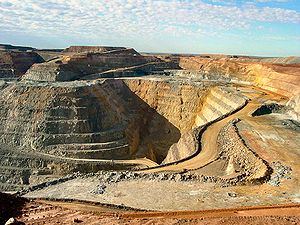
Gold Mine
Gold mining in China has recently made that country the world's largest gold producer. For the year 2007, gold output rose 12% from 2006 to 276 tonnes (or 9.7 million ounces) to become the world's largest for the first time -- overtaking South Africa, which produced 272 tonnes.
History
Gold mining in China dates back to the Song Dynasty.
In recent years, domestic gold production has risen by 15% annually compared to the 3% decline in global production in 2006. This tremendous increase has been due to rapid capital expansion and low costs of labor. Chinese gold producers have gained enormously from the record high gold prices as investors worldwide are seeking stability due to the decline in the value of the dollar.
Scale
Domestic producers still suffer from a lack of scale. In 2000, there were about 2,000 gold producers - most of them relatively small and unsophisticated by international standards. Few are able to operate on a global platform, though the number of producers had shrunk to about 800 in 2007 after mergers and acquisitions and restructuring and consolidation. Most of these firms' technological standards and management are weak and inefficient.
The country's oldest and largest gold producer is the China National Gold Group Corporation (CNGGC), which accounts for 20% of total gold production in China and controls more than 30% of domestic reserves. CNGGC also controls Zhongji Gold, the first publicly listed gold mining company in China.
Production and reserves
China's gold reserves are relatively small (about 7% of the world total). Production has usually been concentrated in the eastern provinces of Shandong, Henan, Fujian and Liaoning. Recently, western provinces such as Guizhou and Yunnan have seen a sharp increase, but from a relatively small base.
Foreign investment
Top foreign investment has come from Canada and Australia. Though foreign investment still constitutes a very important part gold mining expansion, since 1995 it has no longer been actively encouraged by the Chinese government.
Vancouver-based Jinshan Gold Mines Inc. started production in July at its Chang Shan Hao gold mine in China's northern province of Inner Mongolia, reaching 19,000 ounces of gold by December 18. The mine is designed to produce about 120,000 ounces of gold per year, making it one of the country's largest producers.
Gold Fields and Australia's Sino Gold Mining Ltd., have set up a joint venture focused on discovering large gold deposits in China with the potential to produce about 500,000 ounces a year. Sino Gold has been buying stakes in Chinese gold deposits and explorers. In May it started production at its Jinfeng mine in southern China, with planned gold production of 180,000 ounces per year.
Demand and consumption
Most of China's gold output stays in the country where it is transformed into jewelry and manufactured items, though the country's export role is increasing. In 2007, fabrication rose 18%, helped by demand from China's increasingly wealthy middle and upper classes. With a rapid rise in domestic demand, China is now the world's fourth largest gold-consuming country. Chinese market demand accounts for 9.2% of worldwide gold consumption.
Future market
In January 2008, China opened its first gold futures market in Shanghai in response to domestic demand for gold, as well as allowing its producers to hedge risks from daily gold price fluctuations.
Down page:Types of commonly used crushers
- Introduction of gold trommel machine
- Mill balls and water influence the effic
- Fault handling of jaw crusher
- process of Stone Aggregates produced by
- How to maintain ball mill with the lubri
- China mining machinery need technology i
- How to choose jaw crusher--let me help y
- Domestic Mining Machinery Trends brief a
- The future development trends and prospe
- The development of ball miller feeding
- Songling advise for the purchase skills
- Mining mechanization hot ascension of Mi
- The property of Flotation Machine
- The Most Important Factor in the Process
- Obvious advantages of ball mill
- Environmental Protection Idea must be st
- The Benefits of central bank cutting int
- Stone production industry promote the c
- The future of the drying equipment in Ch
- Rock Crusher Maintenance

 Jenny
Jenny